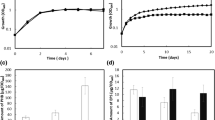Abstract
In bacteria, anaplerotic carbon fixation necessary for growth on carbon sources that are metabolized to three-carbon intermediates is provided by the activity of pyruvate carboxylase (PYC) and/or phosphoenolpyruvate carboxylase (PPC). In contrast to other rhizobia, which encode only one of these enzymes in their genomes, Bradyrhizobium japonicum USDA110 encodes both. Streptavidin-HRP western blot analysis of B. japonicum extracts demonstrated the presence of a biotin-containing protein whose molecular mass was indistinguishable from those of PYCs produced by Sinorhizobium meliloti and Rhizobium etli. Sequence analysis of the possible B. japonicum PYC revealed the lack of a pyruvate binding site as well as other characteristics indicating that the enzyme is non-functional, and PPC activity, but not PYC activity, was detectible in extracts prepared from strain USDA110. A B. japonicum cosmid genomic library was used to clone the ppc by functional complementation of S. meliloti pyc mutant RmF991. S. meliloti RmF991-carrying plasmids containing the B. japonicum ppc regained the ability to grow with glucose as a carbon source and produced PPC activity. The cloned ppc gene was inactivated by insertion mutagenesis and recombined into the USDA110 genome. The resulting ppc mutant was essentially devoid of PPC activity and grew poorly with glucose as carbon source in comparison to the wild-type strain. These data indicate that B. japonicum utilizes PPC, and not PYC, as an anaplerotic enzyme for growth on carbon sources metabolized to three-carbon intermediates.




Similar content being viewed by others
References
Alexeyev MF, Shokolenko IN, Croughan TP (1995) Improved antibiotic resistance gene cassettes and omega elements for Escherichia coli vector construction and in vitro deletion/insertion mutagenesis. Gene 160:63–67
Boyer HW, Roulland-Dussoix D (1969) A complementation analysis of the restriction and modification of DNA in Escherichia coli. J Mol Biol 41:459–472
Brom S, Garcia-de los Santos A, Cervantes L, Palacios R, Romero D (2000) In Rhizobium etli symbiotic plasmid transfer, nodulation capacity and cellular growth require interaction among different replicons. Plasmid 44:34–43
Charles TC, Aneja P (1999) Methylmalonyl-CoA mutase encoding gene of Sinorhizobium meliloti. Gene 226:121–127
Ditta G, Stanfield S, Corbin D et al (1980) Broad host-range DNA cloning system for gram-negative bacteria: construction of a gene bank of Rhizobium meliloti. Proc Natl Acad Sci USA 77:7347–7351
Duangpan S, Jitrapakdee S, Adina-Zada A et al (2010) Probing the catalytic roles of Arg548 and Gln552 in the carboxyltransferase domain of the Rhizobium etli pyruvate carboxylase by site-directed mutagenesis. Biochem 49:3296–3304
Dunn MF (1998) Tricarboxylic acid cycle and anaplerotic enzymes in rhizobia. FEMS Microbiol Rev 22:105–123
Dunn MF, Encarnación S, Araíza G et al (1996) Pyruvate carboxylase from Rhizobium etli: mutant characterization, nucleotide sequence, and physiological role. J Bacteriol 178:5960–5970
Dunn MF, Araíza G, Finan TM (2001) Cloning and characterization of the pyruvate carboxylase from Sinorhizobium meliloti Rm1021. Arch Microbiol 176:355–363
Dunn MF, Araíza G, Encarnación S et al (2002) Characteristics and metabolic roles of biotin-dependent carboxylases in rhizobia. In: Finan TM, O’Brian M, Layzell D, Vessey K, Newton W (eds) Nitrogen fixation: global perspectives. CAB International, Wallingford, pp 158–162
Friedman AM, Long SR, Brown SE et al (1982) Construction of a broad host range cosmid cloning vector and its use in the genetic analysis of Rhizobium mutants. Gene 18:289–296
Hanahan D (1983) Studies of transformation of E. coli with plasmids. J Mol Biol 166:557–560
Izui K (1970) Kinetic studies on the allosteric nature of phosphoenolpyruvate carboxylase from Escherichia coli. J Biochem 68:227–238
Jonathan DG, Gutterson N (1987) An efficient mobilizable cosmid vector, pRK7813, and its use in a rapid method for marker exchange in Pseudomonas fluorescens strain HV37a. Gene 61:299–306
Kaneko T, Nakamura Y, Sato S et al (2002) Complete genomic sequence of nitrogen-fixing symbiotic bacterium Bradyrhizobium japonicum USDA110. DNA Res 9:189–197
Liao C-L, Atkinson DE (1971) Regulation of the phosphoenolpyruvate branchpoint in Azotobacter vinelandii: Phosphoenolpyruvate carboxylase. J Bacteriol 106:31–36
Lorow D, Jessee J (1990) Max efficiency DH10BTM; a host for cloning methylated DNA. FOCUS (Life Technol) 19:28–29
McDermott TR, Griffith SM, Vance CP et al (1989) Carbon metabolism in Bradyrhizobium japonicum bacteroids. FEMS Microbiol Rev 63:327–334
Noel KD, Sánchez A, Fernández L, Leemans J, Cevallos MA (1984) Rhizobium phaseoli symbiotic mutants with transposon Tn5 insertions. J Bacteriol 158:148–155
Peters-Wendisch PG, Wendisch VF, de Graaf AA et al (1996) C3-Carboxylation as an anaplerotic reaction in phosphoenolpyruvate carboxylase-deficient Corynebacterium glutamicum. Arch Microbiol 165:387–396
Peters-Wendisch PG, Kreutzer C, Kalinowski J et al (1998) Pyruvate carboxylase from Corynebacterium glutamicum: characterization, expression and inactivation of the pyc gene. Microbiology 144:915–927
Sambrook J, Fritsch EF, Maniatis T (1989) Molecular cloning: a laboratory manual, 2nd edn. Cold Spring Harbor Laboratory, Cold Spring Harbor
Selbitschka W, Niemann S, Pühler A (1993) Construction of gene replacement vectors for Gram-negative bacteria using a genetically modified sacRB gene as a positive selection marker. Appl Microbiol Biotechnol 38:615–618
Simon R (1984) High frequency mobilization of gram-negative bacterial replicons by the in vitro constructed Tn5-mob transposon. Mol Gen Genet 196:413–420
St. Maurice M, Reinhardt L, Surinya KH et al (2007) Domain architecture of pyruvate carboxylase, a biotin-dependent multifunctional enzyme. Science 317:1076–1079
Taki K, Yoshihiko S, Uchida A (1998) ppc, the gene for phosphoenolpyruvate carboxylase from an extremely thermophilic bacterium, Rhodothermus obamensis: cloning, sequencing and overexpression in Escherichia coli. Microbiology 144:1423–1434
Thompson JD, Higgins DG, Gibson TJ (1994) CLUSTAL W: improving the sensitivity of progressive multiple sequence alignment through sequence weighing, positions-specific gap penalties and weight matrix choice. Nucleic Acids Res 22:4673–4680
Vincent JM (1970) A manual for the practical study of root nodule bacteria. Blackwell Scientific Publications, Oxford, p 3
Acknowledgments
I thank Gisela Araíza for excellent technical assistance, Laura Green (University of Missouri-Columbia) for providing the B. japonicum cosmid library and the laboratory of Dr. Guillermo Dávila of the Centro de Ciencias Genómicas-Universidad Nacional Autónoma de México for nucleotide sequencing. Partial financial support was provided by Grant 3232P from CONACyT, Mexico.
Author information
Authors and Affiliations
Corresponding author
Rights and permissions
About this article
Cite this article
Dunn, M.F. Anaplerotic Function of Phosphoenolpyruvate Carboxylase in Bradyrhizobium japonicum USDA110. Curr Microbiol 62, 1782–1788 (2011). https://doi.org/10.1007/s00284-011-9928-y
Received:
Accepted:
Published:
Issue Date:
DOI: https://doi.org/10.1007/s00284-011-9928-y




